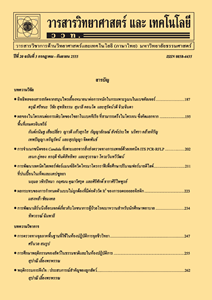มวลชีวภาพและการสะสมแคโรทีนอยด์ในสาหร่ายสีเขียวขนาดเล็ก สายพันธุ์ PY202 ภายใต้สภาวะมิกโซโทรฟิก
Main Article Content
Abstract
บทคัดย่อ
แคโรทีนอยด์เป็นรงควัตถุที่มีสมบัติการเป็นสารต้านอนุมูลอิสระที่มีประสิทธิภาพสูง โดยเฉพาะอย่างยิ่ง แคโรทีนอยด์กลุ่มคีโตแคโรทีนอยด์ ดังนั้นจึงมีการนำสารกลุ่มนี้ไปใช้ทั้งในด้านโภชนาการ เภสัชศาสตร์ และอุตสาหกรรมความงาม นับได้ว่าเป็นสารสีที่มีความสำคัญทางเศรษฐกิจ หากแต่พบได้ในสิ่งมีชีวิตเพียงไม่กี่ชนิดเท่านั้น งานวิจัยนี้มุ่งศึกษาสาหร่ายสีเขียวขนาดเล็ก PY202 ซึ่งคัดแยกจากดินโป่งยุบ อำเภอสวนผึ้ง จังหวัดราชบุรี ซึ่งมีความสามารถในการสังเคราะห์และสะสมคีโตแคโรทีนอยด์ มีแคนธาแซนธินเป็นรงควัตถุเด่น โดยลำดับนิวคลีโอไทด์ของยีน 18S rRNA ในสาหร่าย PY202 นี้ มีความคล้ายคลึงกับสาหร่าย Hylodesmus singaporensis (95 %) การศึกษารูปแบบการเจริญพบว่าสาหร่าย PY202 สามารถเจริญได้ทั้งในสภาวะออโตโทรฟิก มิกโซโทรฟิก และเฮเทอโรโทรฟิก โดยภายใต้สภาวะมิกโซโทรฟิกซึ่งมีน้ำตาลกลูโคสเป็นแหล่งคาร์บอนนั้นช่วยส่งเสริมให้สาหร่าย PY202 มีการผลิตมวลชีวภาพเพิ่มมากขึ้นจากชุดควบคุมถึงประมาณ 4 เท่า (p<0.05) อีกทั้งการเติมน้ำตาลกลูโคสที่ระดับความเข้มข้น 20 กรัมต่อลิตร สามารถกระตุ้นให้สาหร่ายนี้มีการสะสมแคนธาแซนธินสูงที่สุดอย่างมีนัยสำคัญเท่ากับ 1,341.31 ไมโครกรัมต่อกรัมน้ำหนักแห้ง ซึ่งมากกว่าชุดควบคุมประมาณ 12 เท่า ผลจากการศึกษานี้แสดงให้เห็นถึงความน่าสนใจและศักยภาพของวิถีสังเคราะห์แคโรทีนอยด์ที่มีมูลค่าสูงภายใต้สภาวะมิกโซโทรฟิกของสาหร่าย PY202
คำสำคัญ : สาหร่ายสีเขียวขนาดเล็ก; กลูโคส; คีโตแคโรทีนอยด์; แคนธาแซนธิน
Abstract
Carotenoids are pigments with a potent antioxidative activity especially, ketocarotenoids. Hence there are lots of applications of these pigments in nutritional supplements, pharmaceutical and cosmetic industries making them economically important. Only a few organisms, however, have been recorded biosynthesizing ketocarotenoids. This study focused on the green microalga PY202, isolated from Pongyub soil, Suanphung, Ratchaburi province that showed an ability to synthesize and accumulate canthaxanthin as a major pigment. A partial 18S rDNA nucleotide sequence of PY202 was found to be 95 % identical to Hylodesmus singaporensis. The investigation of growth pattern discovered that PY202 was able to grow autotrophically, mixotrophically and heterotrophically. Under mixotrophic condition, supplying glucose as an exogenous carbon source with light, PY202 was significantly stimulated to produce approximately 4-times higher biomass than the control. In addition, a 20 g/l glucose supplementation accelerated canthaxanthin accumulation to its highest at 1,341.31 µg/g DW which is nearly 12-fold higher than the control. The findings from this study have highlighted the attractiveness and potential of high-value carotenoid biosynthesis under mixotrophic condition of PY202 alga.
Keywords: green microalgae; glucose; ketocarotenoid; canthaxanthin


